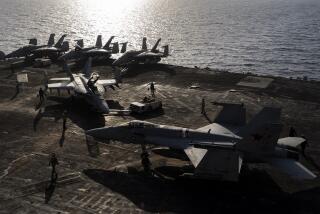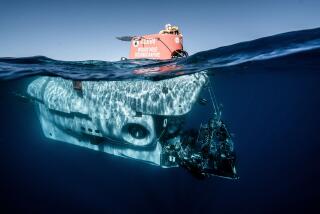One Era Ends, Another Begins for Subs : Military: The Blueback, the last remaining diesel-powered U.S. submarine, has been retired, ushering in an all-nuclear-powered submarine fleet.
When the commissioning pennant was broken off the submarine Blueback and the colors were lowered Monday, Navy officers and sailors saluted the end of an era as the last remaining diesel-powered U.S. submarine retired--making the U.S. Navy the world’s first submarine fleet completely powered by nuclear energy.
“After the Blueback crew has left, it will become a hunk of cold, black metal. . . . It has been her crew that made her come alive,” said Cmdr. Thomas A. Grassi, commanding officer of the Blueback. “When I demanded, they gave. When I asked, they gave more. When I backed off to give them a rest, they gave me more. . . . Now is the time to say farewell to an era and to a gallant lady.”
Grassi choked with tears and ordered the breaking of the commissioning pennant, a narrow red, white and blue pennant with seven white stars. The crowd gathered at thePoint Loma Submarine Base, at Ballast Point, Monday afternoon stood and saluted as the band played taps. After three whistles, Grassi ordered: “Secure the watch.”
White-uniformed, solemn sailors marched single file off the submarine. Grassi ordered the navigator to bring him the deck log, which he signed after the last sailor departed. Eyes grew moist as a hymn was sung.
With those gestures, the Blueback was forsaken--making way for the sleeker, larger, nuclear-powered submarines that travel at speeds up to 40 knots and remain submerged for more than 10,000 miles.
The Navy did not reveal what it plans to do with the retired sub.
With the departure of the Blueback, the submarine that impersonated a Soviet sub in the film “The Hunt for Red October,” the Navy will realize the dream of Adm. Hyman G. Rickover: an all-nuclear-powered submarine fleet.
“It just makes me homesick. That is one special submarine--I’d go back and do it again if I wasn’t so old,” said Donald F. Saur, a 70-year-old San Diego resident who served on the original Blueback, which was commissioned in 1944. That ship, named after the blueback salmon, completed three patrols in the South China and Java seas in World War II before it was turned over to Turkey in 1948.
In 1959, a second Blueback was commissioned--the one that departed in Monday’s ceremony after more than 30 years of service. For most of those gathered, it was a time for nostalgia and tears.
“No longer can you tell a submariner by that distinctive aroma--diesel fuel,” joked retired Capt. Robert H. Gautier, who was the commanding officer of the Blueback at the time of its commissioning.
Many, like Gautier, had come to the ceremony even though they had left the Navy. And some, like Rod Jones, came from across the country.
Jones, a farmer in Winterset, Iowa, had served as a fire control technician aboard the Blueback for four years, starting in 1968.
“It had been a childhood dream to be on submarines,” said Jones, who left the Navy in 1972. “You never forget your submarine. She’s just part of your life. It’s like being married once in the lifetime and losing her--she’ll be part of your life forever.”
Submarines powered by diesel engines on the surface and electric motors underwater, like the Blueback, still rule the oceans. The rest of the world’s 44 navies--including the Soviet and British--use some or all diesel-electric-powered subs, 400 in all, and continue to build them.
The newest diesel-electric submarines are considered superior to nuclear submarines in some important respects--notably, cost and silence. While they are slower than nuclear subs and cannot stay submerged as long, diesel subs sometimes are preferred in close-range situations.
“The irony is that a non-nuclear submarine, when it’s operating on its batteries, is quieter than a nuclear submarine,” said Norman Polmar, one of the world’s leading experts on submarines.
“Diesel subs are smaller, much cheaper and require many fewer people. They are considered very cost-effective for a large number of missions, such as operating in restricted areas like the Mediterranean and the Far East,” said Polmar, an editor of “Jane’s Fighting Ships” and author of “The American Submarine.”
United Press International contributed to this report.
More to Read
Sign up for Essential California
The most important California stories and recommendations in your inbox every morning.
You may occasionally receive promotional content from the Los Angeles Times.










